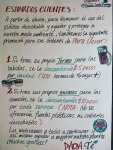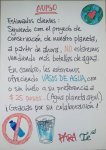These images are being shared in social media and making headlines in mainstream media. It could have a devastating effect on the tourism industry. Anyone who knows the DR will recognise the location: not tourist beaches as implied by some reports, but the Santo Domingo shoreline near the mouth of the Ozama River.
https://www.bbc.com/news/av/world-44914919/wave-of-plastic-hits-dominican-republic
Following the recent storm (Beryl) the waste was swept down the river, which is lined with poor neighbourhoods with inadequate or nonexistent drainage and waste collection systems, and a culture where casual littering is still acceptable.
It's been several decades since city beaches like Montesinos and Guibia were regularly used by swimmers. Even so, the Malecon seafront boulevard of Santo Domingo is being promoted as a cultural tourist attraction along with the Colonial city, which is also near the river mouth. This is just round the corner from the cruise ship terminal (cruise ship tourism being one of the most polluting models of tourism, but that’s a separate issue).
Across all social classes, single-use plastic and Styrofoam is overused and discarded every day: bottles, cups, plates, cutlery, plastic bags, and takeaway food containers.
Over in the tourist areas obscene amounts of plastic waste are generated: thousands of plastic bottles and cups are used and discarded in the resorts every day. Although there are some honourable exceptions like the Grupo Puntacana initiatives where a good proportion of the waste generated is collected, separated and recycled, even when these plastic and foam items are disposed of systematically and responsibly, most still end up in landfill, open-air dumps, or floating in the sea.
The Ministry of Tourism with its stated goal of 10 million tourists must legislate and – more importantly - enforce new standards on plastics and waste management, and the tourist industry should take its own initiative to reduce single-use plastics to an absolute minimum in resorts, hotels, restaurants, cafes and bars.
A small restaurant in Santo Domingo, Para Te, is one example - from now on they will only serve drinking water in glasses and are offering a discount to takeaway customers who bring their own containers:


More education and enforcement of penalties is needed to stop taxi and bus drivers from littering their rest areas-a common but shocking sight along the roads and highways-which discourages many visitors from ever wanting to return.
https://www.bbc.com/news/av/world-44914919/wave-of-plastic-hits-dominican-republic
Following the recent storm (Beryl) the waste was swept down the river, which is lined with poor neighbourhoods with inadequate or nonexistent drainage and waste collection systems, and a culture where casual littering is still acceptable.
It's been several decades since city beaches like Montesinos and Guibia were regularly used by swimmers. Even so, the Malecon seafront boulevard of Santo Domingo is being promoted as a cultural tourist attraction along with the Colonial city, which is also near the river mouth. This is just round the corner from the cruise ship terminal (cruise ship tourism being one of the most polluting models of tourism, but that’s a separate issue).
Across all social classes, single-use plastic and Styrofoam is overused and discarded every day: bottles, cups, plates, cutlery, plastic bags, and takeaway food containers.
Over in the tourist areas obscene amounts of plastic waste are generated: thousands of plastic bottles and cups are used and discarded in the resorts every day. Although there are some honourable exceptions like the Grupo Puntacana initiatives where a good proportion of the waste generated is collected, separated and recycled, even when these plastic and foam items are disposed of systematically and responsibly, most still end up in landfill, open-air dumps, or floating in the sea.
The Ministry of Tourism with its stated goal of 10 million tourists must legislate and – more importantly - enforce new standards on plastics and waste management, and the tourist industry should take its own initiative to reduce single-use plastics to an absolute minimum in resorts, hotels, restaurants, cafes and bars.
A small restaurant in Santo Domingo, Para Te, is one example - from now on they will only serve drinking water in glasses and are offering a discount to takeaway customers who bring their own containers:


More education and enforcement of penalties is needed to stop taxi and bus drivers from littering their rest areas-a common but shocking sight along the roads and highways-which discourages many visitors from ever wanting to return.

